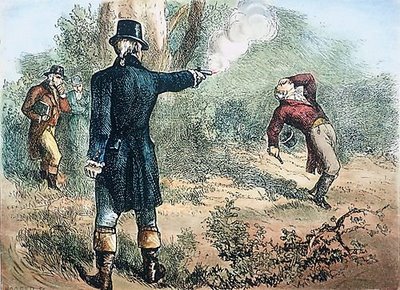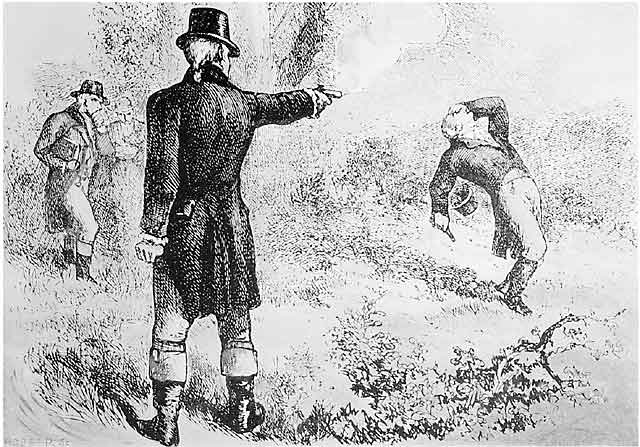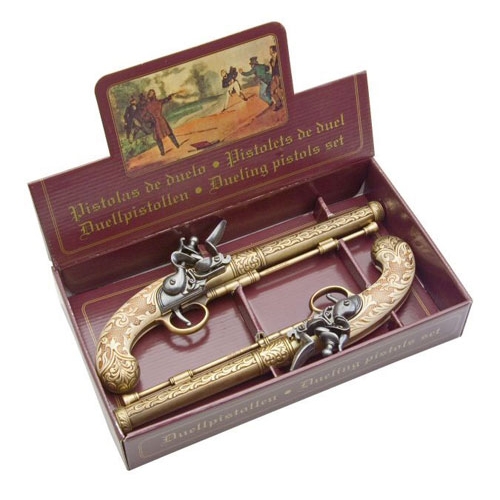|
|
|
City Park was the favorite site of New Orleans' Creole gentlemen's “affaires d’honneur,” under the "Dueling Oaks." Duels were fought for major, and often minor reasons, such as perceived assaults on the honor of the ladies or gentlemen--you could literally look at somebody in the "wrong way" and find yourself on the wrong end of a pistol.The duels were fought until first blood was drawn, and many resulted in death. This practice was not outlawed until 1890. In early Creole days more duels were fought in New Orleans than any other American city. Creole honor was a thing of intricate delicacy, to be offended by a word or glance. The Duelling Oaks were a favorite setting for these affaires d'honneur, with pistol, saber, or colichemarde, a long sword with a broad forte and very slender foible, a favorite duelling weapon since the seventeenth century.
Creoles were expert swordsmen and often delighted in any and every opportunity to exhibit their art. Duels were fought over real and trivial insults, were sometimes deliberately provoked by young men anxious to display their skill. A quarrel between rival lovers, a fancied slight, a political argument, a difference of opinion regarding an opera, any one of these things was ample excuse for a duel under the oaks. In his History of Louisiana, Alcee Fortier states that on one Sunday in 1839 ten duels were fought here.
Many of the most prominent figures in the New Orleans of the era took part in duels in City Park. Bernard Mandeville de Marigny, famous in the city's history, is said to have fought nineteen duels beneath the Oaks. Micajah Green Lewis, secretary to Governor Claiborne, was killed here in a duel in 1804. Residents of the neighborhood grew accustomed to watching the daily processions to the Oaks and to seeing them depart, often one man being carried away, perhaps to his family for burial. Of course, duels did not always terminate in a fatality; often injured dignity was appeased by the first blood drawn, and the duellists sometimes left the park arm in arm.
Many of the contests ending at the Duelling Oaks began in ballrooms. A popular lady might be asked for half a dance belonging to another gentleman. No argument would ensue on the refusal of the first gentleman to relinquish his partner, but the next morning the thwarted gallant would see that the other received a challenge to a meeting at the Oaks, the whole affair conducted with exquisite politeness. By evening one or the other of the gentlemen might have performed his last courtly bow in this world.
Bienaime Christe de Lauzon and a certain M. Morel duelled to the death for less reason than that. De Lauzon, at a supper, moved his sister's chair a bit too close to the chair of the young lady Morel was escorting. Immediately Morel called upon de Lauzon to step out on the balcony, where he slapped him in the face with a glove. Two days later they met in City Park, and de Lauzon was killed.
Bernard de Marigny escorted Anna Mathilda Morales, whom he later married, to a ball, excluded all other admirers and thereupon was the recipient of seven challenges. The dashing de Marigny met them all, one by one, and, one by one, they fell under his expert swordsmanship.
Famous in the early 1800's was Emile La Sere, one time U. S. Congressman from New Orleans. La Sere fought eighteen duels during his life. A small man, "scarcely above the weight and height of a fourteen-year-old boy," his impulsive and fiery temper kept him almost constantly embroiled in trouble of one sort or another. Kind-hearted and generous in his less intense moments, La Sere's anger was always left on the duelling grounds. He would carefully bandage the very wounds he inflicted aSourcend sit up all night beside the bed of the man he had put there.
e








